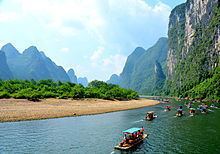Chinese 漓江 IPA [lǐ tɕjáŋ] Source Mao'er Mountains Cities Guilin | Hanyu Pinyin Length 83 km Country China | |
 | ||
Similar Elephant Trunk Hill, Yulong River, Reed Flute Cave, Moon Hill, Jingjiang Princes' City | ||
The Li River (Chinese: 漓江; pinyin: Lí jiāng) is a river in Guangxi Zhuang Autonomous Region, China. It flows 83 kilometres (52 mi) from Guilin to Yangshuo, where the karst mountains and river sights highlight the famous Li River cruise.
Contents
Map of Guijiang River, China
Background
The Li River originates in the Mao'er Mountains in Xing'an County and flows in the general southern direction through Guilin, Yangshuo and Pingle. In Pingle the Li River merges with the Lipu River and the Gongcheng River and continues south as the Gui River, which falls into the Xi Jiang, the western tributary of the Pearl River, in Wuzhou.
The upper course of the River Li is connected by the ancient Lingqu Canal with the Xiang River, which flows north into the Yangtze; this in the past made the Li and Gui Rivers part of a highly important waterway connecting the Yangtze Valley with the Pearl River Delta.
The 437-kilometre (272 mi) course of the Li and Gui Rivers is flanked by green hills. Cormorant fishing is often associated with the Lijiang (see bird intelligence).
Tourist cruises in different boats (varying from small bamboo-like rafts to larger, air-conditioned ships) are offered on the Li River throughout the year and are one of the major attractions of Guilin.
Features
- Reed Flute Cave: a limestone cave with a large number of stalactites, stalagmites, stalacto-stalagmites, rocky curtains, and cave corals.
- Seven-Star Park: the largest park in Guilin.
- Mountain of Splendid Hues: a mountain consisting of many layers of variously colored rocks.
- Elephant-Trunk Hill: a hill that looks like a giant elephant drinking water with its trunk. It is symbol of the city of Guilin.
- Lingqu Canal: dug in 214 BC, is one of the three big water conservation projects of ancient China and the oldest existing canal in the world.
- Other attractions include: Duxiu Peak, Nanxi Park, the Taohua River, the Giant Banyan, and the Huashan-Lijiang National Folklore Park.
The imagery of the Li River is featured on the fifth series of the 20 yuan note.
